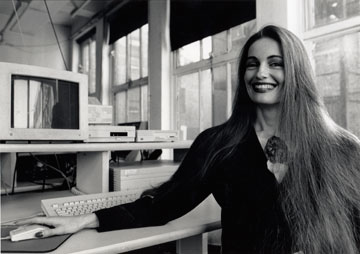Fractals, Particles & Morphs
The first computer animated piece I saw was Ed Emschwiller’s “Sunstone” in 1981 and it blew my mind. The colors melted into one anther like they did in my Visions! I was hooked. There were a few spectacular pieces I remember from the early decade: Karl Sims’ “Particle Dreams,” Yoichiro Kawaguchi’s “Embryo,” NYIT’s music video of Kraftwerk’s “Music Nonstop,” Robert Abel & Associates “Brilliance” commercial (“Sexy Robot”) and Larry Cuba’s “Calculated Movements,” to name just a few from that time.
SIGGRAPH
I became a computer animator during its infancy, in 1982. I was among the first women in the field. Artistically, I grew up with the technology. My first SIGGRAPH (the Association for Computing Machinery’s Special Interest Group on Computer Graphics and Interactive Techniques) was in Detroit 1983. Breakthroughs in math, scientific visualization, and image computing brought astounding new imagery to the world. Each SIGGRAPH was like Christmas, with magical new ideas, lectures, artworks, and videos. I LOVED it!
Digital Color
I’m what you could call an early “digital immigrant.” As an artist, instead of learning color with paints, I learned color on the computer when I created the first interactive version of Josef Albers’ “Interaction of Color.” Before that project, I had been working exclusively in black and white (pencil) for five years, to master volume, form, contour, lighting, texture, and so on. Perhaps the metaphysical guides wanted me to eliminate color so I would learn it using the new tools. “Interaction of Color” was traditionally taught with squares of colored paper and my job was to make it on a computer monitor. I had to specify quantities of red, green, and blue light. There were 150 original color plates, and I made up to 100 variations of each. In those days, I could look at any object—say, blue jeans—and rattle off the digital color “recipe” e.g. 72, 96, 121. I got pretty fluent in speaking digital color to a DEC PDP 11/34! That piece was the first interactive color piece shown at the Guggenheim in NYC. The Mac II—Apple’s first color computer—had just come out.
Grinding Our Own Digital Pigments
Pre-Maya
Most artists back in the ’80s were deeply offended by computer graphics. You could say they loathed the new technology! 3D animation came from the military flight simulation effort, and ultimately—war. Aesthetically, it was an ugly stepchild, known for florid fractal landscapes, checkerboard floors, bizarre teapots and chrome spheres, and of course metallic flying logos.
My article “The Chrome Age: Dawn of Virtual Reality” explores the “primitive” period of digital animation. That “software” was excruciating to use. Before tablets, when I worked on “Star Trek II: The Search for Spock,” we pretty much had to build geometry point by point, plotting out three dimensions on graph paper and typing in not only the coordinates (x, y, z) but defining their connections into tiny triangles (polygons) by hand! All this, just to describe a 3D surface. The most complicated object I build during that time was a saxophone whose keys animated in time to the music (they were the correct fingerings!). That primitive software evolved into Maya, but in those days you really had to be geeky and nerdy to use it.
Compared to my traditional artist friends (and also to the geeks!) I was a loner in the field back then. But I stuck it out because I felt passionately about using digital effects for spiritual purposes. I wanted the new technology to bring peace, healing, and great imagination to people—a dream that started coming true when computer animated feature films took off in the ’90s (after the Cold War, many CG visualization geniuses migrated from the government and military into entertainment).
Pre-Photoshop
Throughout my career I helped make software friendlier for artists. There were no manuals at the beginning, and I wrote one for Alvy Ray Smith’s “Big Paint” in 1983 by gathering software hints and adding tips of my own. Later, when I worked on the GAIN engine for artificial intelligence in computer games, I designed a “Body-Heart-Mind” interface to address different levels of character behavior and motivation. I’ve always admired truly artist-friendly tools like Pixar’s “Marionette” animation interface. Of course, software is ubiquitous and very friendly now, and everyone is a “digital artist” of sorts with their mobile devices! I taught lots of talented folks over the years. I developed MDA, BFA, and Continuing Education curriculae for digital animation and computer art at Pratt Institute, School of Visual Arts (SVA), and in workshops in Korea, HongKong, and Beijing.
Stumbling Backward into… Purpose!
Most people start their artistic careers with drawing and painting, and then progress into film, video, or animation later in life. As a fine artist, I went the reverse route! I started with drawing as a kid, spent my youth in CG animation and effects, then became a videographer, then a photographer, and finally a digital fine artist!
I love creating each and every piece. It is my sincere hope to bring awakening, higher awareness, and spiritual healing to people through art. I intend to create artwork as long as I am humanly able, and to learn each day how to be a better artist and person. I hope whichever works you buy—whether posters, greeting cards, and oracle decks or Mystic Murals™, giclée prints, or Mystic Treasure Boxes™—bring you and your loved ones true meaningfulness, grace, and beauty.


